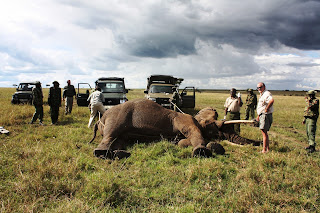What I have learned in life and of wildlife this year
“In my heart I believe that people are good, but my
experience has shown me otherwise.”
“Unless you are directly affected by some issue whether it
be conservation or politics you are not going to do anything about it.”
“If you donate to most non-profit organizations that prey on
your emotions to extort monies more than likely only 5% of the funds reach the
persons on the ground frontlines.”
“If you want loyalty get a dog.”
“True love takes time.”
“I have always been spiritual in my soul, I know angels have
been protecting me all my life I finally acknowledged my faith and life has
been wonderful since then”.
“Treat everyone as an equal and you gain their respect.”
“You can learn everything about life by observing wildlife.”
“You can’t lead a happy life without passion.”
From Fred a veterinary assistant in Kenya after being
charged by wounded elephant…..
Day 1 “Dr I learned something new today… age doesn’t
matter.. But you are crazy.”
Day 10 “Dr I learned something new this week … “Not all
white men are the same.”
It’s been a year of mixed emotions and I have always said
you can’t show weakness so “ you shut up, you buck up . And you carry on”
“Have fun don’t sweat the small things…Life is short.. Make
a difference”
“Age gracefully the other alternative we will all find out”.
“You can’t make a spring chicken out of an old rooster”.
“My disabled dog Tacca Roo doesn’t know she is disabled and
she is pure love”.
“Give form the heart and you will receive tenfold back”.
“Vindictiveness gets you nowhere but the facts will”.
“Stand your ground your integrity is all you really have”
“When you lose it all you have you realize what is important
in life”.
“Material possessions are just things”.
“Every day brings a new opportunity, if doors close others
open”.
“Never give up until you are dust”.
“Speak what you believe is true in your heart it will often
get you in deep trouble but you will sleep soundly at night”.
“Always tell the truth lies are always revealed”.
(I have no clue where this all came from I feel like my
words just poured out of me with no forethought
… divine intervention once again.)
I have been blessed to have the opportunity to work with Sheldricks
elephant orphanage and get much closed to elephants that I was able to in the
wild. My love and passion has only grown.
From the veterinary viewpoint I believe we have learned a
lot of new things.
1.
Baby elephants seem to have a common problem
while they are teething that stresses them and gives them diarrhoea and in
captivity this is often fatal.
a.
Addition of pancreatic enzymes to predigest
their milk works and has saved many babies since its diagnosis and introduction
in April
b.
I suggested using anaesthetic baby oral gel on gums during that time or even
the administration of injectable pain Killers every few days
c.
I suggest a program to dart wild lactating
elephants at different stages so we can analyse the composition of the milk and
enzymes. I suspect that the mother secretes digestive enzymes and natural pain
killers in the milk. It’s possible they may be eating a certain foodstuff that
may promote this .
d.
The use of in house blood machines and digital x-rays
as donated to Sheldricks ,allows you to
diagnose a problem before it becomes critical and it saves lives.
2.
In Kenya the poachers use a very powerful poison
made from different plants. This is so toxic that one drop can kill 10
men. Let’s find and antidote….
I also learned not to poke around in spear
wounds with my fingers I will use a forceps from now on.
3.
We need to vaccinate and sterilize domestic dogs
that are surrounding these game reserves. The dogs I saw were in very bad
condition. We cannot have an outbreak of infectious diseases such as Distemper
or Parvo virus that in my experience wiped out all the predators in Chobe one
year. They still have not learned their lesson
4.
The men on the frontlines on the field need to
utilize the new technologies available. We need to raise funds to buy them
Portable handheld blood machines to diagnose the survivability of sick animals
in the field. They need Pulse Oximiters that monitor the heart beat and
respiration of sedated animals so that we can be aware of a problem while we
are working on the treatment. Wild animals often succumb to anaesthetic mishaps and need to be monitored just as in a
hospital
5.
Use of Unmanned Aerial Vehicles or Drones should
be used to patrol vast areas for poachers. The infra-red capability can detect
these insurgents at night and then an 24/7 heclicopterized antipoaching unit
can respond as they can have night vision capabilities. This is when poachers
are most active. IAPF has used this in Zimbabwe and we have suggested it for years
now. “Blind Ears”.

























































